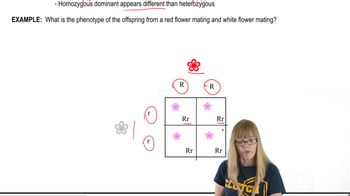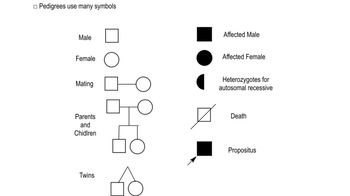Table of contents
- 1. Introduction to Genetics51m
- 2. Mendel's Laws of Inheritance3h 37m
- 3. Extensions to Mendelian Inheritance2h 41m
- 4. Genetic Mapping and Linkage2h 28m
- 5. Genetics of Bacteria and Viruses1h 21m
- 6. Chromosomal Variation1h 48m
- 7. DNA and Chromosome Structure56m
- 8. DNA Replication1h 10m
- 9. Mitosis and Meiosis1h 34m
- 10. Transcription1h 0m
- 11. Translation58m
- 12. Gene Regulation in Prokaryotes1h 19m
- 13. Gene Regulation in Eukaryotes44m
- 14. Genetic Control of Development44m
- 15. Genomes and Genomics1h 50m
- 16. Transposable Elements47m
- 17. Mutation, Repair, and Recombination1h 6m
- 18. Molecular Genetic Tools19m
- 19. Cancer Genetics29m
- 20. Quantitative Genetics1h 26m
- 21. Population Genetics50m
- 22. Evolutionary Genetics29m
2. Mendel's Laws of Inheritance
Pedigrees
Problem 4
Textbook Question
In mice, black coat color is dominant to white coat color. In the pedigree shown here, mice with a black coat are represented by darkened symbols, and those with white coats are shown as open symbols. Using allele symbols B and b, determine the genotypes for each mouse.
 Verified step by step guidance
Verified step by step guidance1
span>Step 1: Understand the genetic basis of coat color in mice. The black coat color (B) is dominant over the white coat color (b). This means that a mouse with at least one B allele will have a black coat, while a mouse with two b alleles will have a white coat.</span
span>Step 2: Analyze the pedigree chart. Identify the phenotype of each mouse (black or white coat) based on the symbols provided (darkened for black, open for white).</span
span>Step 3: Assign possible genotypes to each mouse. Start with the white-coated mice, as they must be homozygous recessive (bb) since white is the recessive trait.</span
span>Step 4: For black-coated mice, consider both homozygous dominant (BB) and heterozygous (Bb) possibilities. Use the information from the offspring and parents to deduce the most likely genotype.</span
span>Step 5: Use Mendelian inheritance rules to confirm the genotypes. Check if the genotypes you assigned can produce the observed phenotypes in the offspring, considering the dominant and recessive allele interactions.</span
Recommended similar problem, with video answer:
 Verified Solution
Verified SolutionThis video solution was recommended by our tutors as helpful for the problem above
Video duration:
3mPlay a video:
Was this helpful?
Key Concepts
Here are the essential concepts you must grasp in order to answer the question correctly.
Dominant and Recessive Alleles
In genetics, alleles are different forms of a gene. A dominant allele, represented by a capital letter (e.g., B), masks the effect of a recessive allele (e.g., b) when both are present in an organism. This means that if an organism has at least one dominant allele, it will express the dominant trait, such as black coat color in mice.
Recommended video:
Guided course

Variations on Dominance
Genotype vs. Phenotype
The genotype refers to the genetic makeup of an organism, specifically the alleles it possesses (e.g., BB, Bb, or bb). The phenotype, on the other hand, is the observable physical trait resulting from the genotype, such as coat color in mice. Understanding the relationship between genotype and phenotype is crucial for predicting traits in offspring.
Recommended video:
Guided course

Gamete Genotypes
Pedigree Analysis
A pedigree is a diagram that depicts the genetic relationships and inheritance patterns within a family or group. It uses symbols to represent individuals and their phenotypes, allowing for the tracking of traits across generations. Analyzing a pedigree helps determine the genotypes of individuals based on their phenotypes and the inheritance patterns observed.
Recommended video:
Guided course

Pedigree Flowchart

 2:48m
2:48mWatch next
Master Pedigree Symbols with a bite sized video explanation from Kylia Goodner
Start learning



